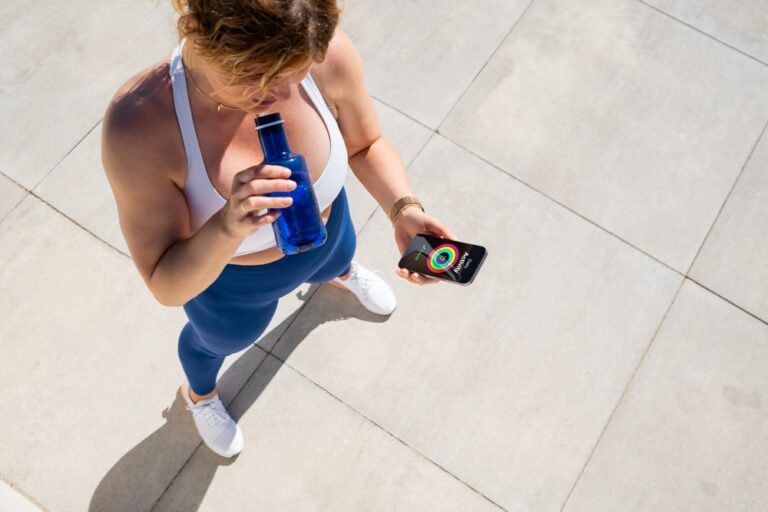You’ve been pushing yourself consistently, seeing steady progress—until one day, you hit a wall. It’s a frustrating spot to be in, but you’re definitely not alone.
Workout plateaus are very common. The good news is, the fix is usually pretty simple if you know why it’s happening and exactly what to do to break through.
This guide will walk you through everything you need to know about workout plateaus. From what they are and why they can happen to the signs you’re in one, and some simple techniques to get back on track and start seeing progress again.
What is a Workout Plateau?
Have you ever been crushing it in the gym for months, making steady progress, but suddenly, everything stops? Whether it’s strength gains, fat loss, muscle growth, or endurance, your body just seems to stop improving.
That’s a workout plateau. This typically happens when you’re putting in the same effort, lifting the same weight, doing the same reps, sets, or distances, and suddenly (usually about 4-6 months into a training program)—your progress comes to a halt.
While other factors can come into play, essentially, your body has adapted to the routine—it no longer needs to change because it’s already adjusted to what you’re asking of it.
For example, a bodybuilder might find that, despite pushing hard in the gym, their muscle growth has stalled. Or a runner might feel stuck at the same speed or distance, no matter how much they push themselves.
Plateaus are usually a natural part of the training process but don’t have to be permanent. Understanding why they happen and recognizing the signs early can help you push past them.
Signs That You’ve Hit a Workout Plateau
Not every stagnation in progress is a true workout plateau. Sometimes, factors like stress, poor sleep, or short-term fluctuations in performance can make it seem like you’re not progressing when, in reality, it’s just a temporary setback. It is also possible that you have maxed out your natural genetic potential, which we will discuss in the next section.
Typically, a workout plateau happens around 4–6 months into a training routine. So, if you are experiencing any of these signs earlier than this, it might not be a true plateau. However, this time frame can vary by person. Sometimes, it happens sooner and sometimes much later.
For example, beginners often experience a longer period of progress before plateauing. On the other hand, someone who has trained before may hit a plateau sooner because their body has already adapted to the previous challenges,
But if you are being consistent, following a healthy diet, and getting enough rest, there are some telling signs that your body may have adapted to your routine, leaving you stuck in a plateau.
You’re Not Challenged by the Weight You’re Lifting
If you seem to have plenty of reps left in the tank (meaning you can perform all your reps and sets easily without feeling challenged and know you could have done quite a bit more), it’s a sign that your body isn’t being pushed enough to grow or get stronger.
You’re Not Seeing Any Changes in Your Body Composition
If you were watching your body tighten up, noticing new muscle definition, and seeing inches fall off (or on if gains were your goal), but suddenly, progress stops or slows dramatically, you may have hit a workout plateau.
Notice we didn’t mention the scale. That’s because scale weight isn’t always the best indicator of a plateau—especially if you’re gaining muscle. However, if your diet is in check, your weight loss might plateau because your body has adapted to your current exercise routine.
Your Body Feels ‘Stuck’ at a Specific Level
Whether it’s strength, endurance, or even flexibility, it’s likely a plateau if your body has hit a wall and feels stuck at a certain level despite consistent effort.
Your Performance Has Stagnated
If you’re not able to lift any heavier, do any more reps, run any faster, progress in your sport, or whatever your training goal is, it’s often a sign that your body has stopped adapting to the same routine, meaning it’s no longer being challenged enough to improve.
You’re Not Tired After a Workout
This can indicate you’re not pushing yourself enough and your body has adapted to the current routine. You should feel at least a little bit fatigued by the end of a challenging session.
You’re Feeling Fatigued, But Not in a Productive Way
Tiredness after a workout is normal. As mentioned, you should feel some fatigue after training. But feeling exhausted all the time or constantly sore without making progress could indicate overtraining, leading to a plateau.
You’re Not Excited About Your Workouts Anymore
The signs of a plateau aren’t always physical. Mental stagnation can be just as much a sign of a plateau as physical stagnation. A consistent lack of enthusiasm and motivation could mean your body has become accustomed to your routine.
Why Do Workout Plateaus Happen?
Before you can implement an effective solution to your workout plateau, you need to know why you’ve hit a workout plateau.
Here are the most common reasons why workout plateaus occur.
Adaptation
Workout plateaus happen for many reasons, but the main culprit is that your body has adapted to your routine. If you are doing the same workout, week after week, with the same exercises, reps, and sets over and over, your body becomes a little too familiar with the routine, and it no longer feels challenged, which leads to stagnation.
Essentially, your body has figured out how to handle the stress you’ve been placing on it and sees it as “the new normal,” so it simply maintains without progressing.
But there’s more to it…
We should clarify that there is nothing wrong with doing the same “basic” exercises over and over again. Some of the basics (like squats, presses, hip thrusts, pulldowns, pull-ups, etc.) are tried and true; they work and, in some form, should almost always be included in your training.
So, it’s not so much exercise variation as it is that you likely aren’t using progressive overload—the principle of gradually increasing the intensity of your workouts to keep pushing your body to adapt.
If you’re not progressively overloading in a strategic way, you’re just going through the motions, and your progress will eventually stall. However, not applying progressive overload isn’t the only reason people plateau.
Diet
There’s another layer to workout plateaus that often gets overlooked: what you eat. Diet can play a significant role in how your body responds to training. A lack of proper fuel can lead to fatigue, reduced performance, and, you guessed it, a plateau.
If your nutrition isn’t on point—whether you’re not eating enough to fuel muscle growth or not getting the proper nutrients for recovery—you’ll struggle to make progress.
Overtraining
Many think that more is better or the solution if they’ve hit a plateau. We see this a lot in competitive bodybuilders and athletes. But pushing your body too hard without giving it time to rest and rebuild can trigger the opposite effect—a plateau or even regression, especially if you’re in a caloric deficit.
If overtraining is the cause of your plateau, the fix might not be as simple as adjusting your training or giving yourself more time to recover. We’ll discuss this more in the “When to Consider Professional Help in Overcoming a Workout Plateau” section below.
Genetic Limits
While not as likely, there is one other possibility… your genetic limits. We are a little hesitant to bring this one up because far too many people use genetics as an excuse. That’s NOT what we mean by genetic limits.
What we mean by genetic limits is that there is usually a point where, genetically, your body won’t keep progressing naturally. You can only gain so much muscle or lose so much fat before you hit a biological ceiling—your genetic potential.
Everyone has a genetic potential limit for muscle growth, strength, and fat loss. However, this limit varies drastically from person to person.
For example:
- Some people naturally build muscle faster due to higher testosterone levels, fiber type distribution, or skeletal structure.
- Others may find it easier to stay lean because of metabolic differences, fat distribution, or hormone balance.
That said, most people never come close to their genetic potential because they don’t train or eat optimally for long enough. Genetics set the ceiling, but training, diet, recovery, and consistency determine how close you get to it.
So, while your genetic limit is not likely the reason for your workout plateau, if you’ve truly optimized your training using progressive overload, a proper diet, and recovery but still aren’t seeing changes, you may be approaching this natural genetic threshold.
What To Do if You Think You’ve Hit a Workout Plateau
Whether you are a beginner, someone returning to training after a break, or even a professional athlete, plateaus can happen. When they do, and assuming the cause is a lack of progressive overload, adequate rest, or your diet, there are some pretty simple techniques you can use to boost progress.
1: Adjust Your Exercise Routine
The first step in breaking through a plateau is to take an honest look at your training and ask yourself if you are truly pushing yourself and maximizing your gym time. Are you increasing the weight you’re lifting, changing up the number of reps and sets you’re doing, or adjusting your training intensity?
You need to keep your body guessing by mixing up the intensity, volume, and focus of your workouts. To stimulate this kind of continuous improvement, you can try these advanced techniques to boost your progress:
Progressive Overload
This is a method where you gradually increase your training intensity, volume, or frequency to challenge your muscles. This can be done by adding more weight, increasing repetitions, or reducing rest periods between sets every week or two or whenever you no longer feel challenged.
Periodization Training
This involves cycling through different training phases—such as focusing on strength, hypertrophy, or endurance—to prevent adaptation and promote continuous progress. By varying the focus and intensity of your workouts over time, you can keep your body challenged and avoid plateaus.
There are several types of periodization training. To learn more about periodization training and how to incorporate it into your training regimen, read “Periodization Training: What It Is, How to Do It, & Benefits.”
Incorporating More Advanced Techniques
Techniques like supersets, drop sets, and circuit training can add intensity and variety to your workouts, helping you push past a plateau. They are also a great way to maximize your gym time.
For example, performing supersets—two exercises back-to-back with minimal rest—can increase training density and improve muscular endurance. Circuit training, which involves rotating through multiple exercises with little to no rest, can also be beneficial for endurance and calorie burn.
Drop sets are another effective way to push past a plateau by extending a set beyond failure. You don’t need to use them for every exercise—just pick one or two key movements and perform an extra drop set after your regular working sets to maximize muscle fatigue and stimulate new growth.
2: Ensure You Are Incorporating Enough Rest and Recovery
It might seem counterintuitive to say you should “do less,” especially if you are in a plateau, but rest is essential for progress. In fact, not getting enough rest could be why you aren’t progressing. Without enough rest, you risk overtraining, which can lead to a plateau.
When you train hard, you create microscopic tears in your muscle fibers. It’s during recovery that your body repairs and rebuilds. No rest, no growth! Rest also allows your central nervous system to recover and helps balance hormones like cortisol.
So, make sure you are giving your body enough rest days. The number of rest days someone needs is highly individual. Always listen to your body, but generally, you should take at least 1-2 days away from training each week.
Also, don’t forget about sleep. Proper recovery isn’t only about taking enough rest days. Getting enough quality sleep is also crucial—this is when your body does the majority of its recovery and growth. Make sure to prioritize going to bed and waking up close to the same time daily, and getting enough quality sleep every night.
3: Take a Look at Your Diet
Your training routine might be on point and balanced with proper rest, but if your diet isn’t supporting your goals, it can contribute to a plateau. Food is fuel! If you’re not eating enough to support your workouts and promote recovery, your body will have a hard time progressing.
Make sure you’re eating enough protein to build or maintain muscle, carbohydrates to fuel your workouts, and healthy fats to support hormone health. If you need help with that, read “Nutrition for Muscle Gain: What to Eat Before and After Workouts.” We also have some great smoothie recipes to boost your performance and recovery.
And don’t think this is only important for guys who want to bulk or athletes who place significant demands on their bodies. It is very common to see people in fat loss phases hit a plateau simply because their body has adjusted to a lower calorie intake.
In that case, you might need to work with a trainer educated in nutrition to help you adjust your caloric intake, cycle your calories, or shift your macronutrient ratios to jumpstart progress again.
Also, don’t forget hydration—proper fluid intake and electrolyte balance are crucial for performance and recovery. If you’re not eating right and staying hydrated, you might sabotage your efforts, even with great workouts.
To learn more about how much water you need, read “The Science of Hydration: How Much Water Do You Really Need.”
How to Keep Motivation High During a Workout Plateau
By making smart adjustments to both your training routine and diet, you should start seeing progress again soon and break through that plateau. In the meantime, it can be frustrating, leading to dips in motivation.
Changing up your workout routine to challenge yourself more might be all you need to keep motivation high during a workout plateau. Something new and different can reignite that lost spark people often feel when they’re stuck in a rut.
However, if you’re still struggling after changing up your workout routine and incorporating enough rest days, here are a few other things that might help:
Reconnect With Your “Why”
Take a moment to remind yourself (and possibly reassess) your “why.” This is your reason for training and wanting to reach your goal. Your “why” could be anything from wanting to get stronger or fitter to achieving a personal milestone.
The key is that you must be very specific. It’s not enough to say “I need to lose weight” or “I want to look buff this summer”—these are too vague and won’t keep you driven on tough days.
You’ve gotta be much more specific than that.
For example, “I want to deadlift 300 pounds by the end of the year to feel stronger and be able to lift my children with ease,” or “I want to lose 10 pounds of body fat over the next three months to feel more confident in my clothes and improve my health markers so I can live a long and healthy life,” or “I want to be able to walk or jog one mile without stopping in three months, so I don’t get as winded when I walk up the steps.”
When your goal is specific, clear, and tied to a meaningful reason, it becomes a lot easier to push through when motivation is lacking.
Adjust Your Goals
Sometimes, adjusting your original goals can also help boost motivation. Ask yourself if you aimed too low or possibly even too high. A goal that leans in either direction could impact your motivation.
Your goals should always be challenging but, at the same time, realistic. For example, if you’re aiming to run a sub-6-minute mile but haven’t been running consistently, a goal of improving your 5K time by a few minutes might be more attainable.
Try Something New
If you always walk on the treadmill, try walking outdoors or hiking in nature. Consider taking a group fitness class if you are stuck climbing the stepmill every single cardio session. Changing the environment or method can bring fresh excitement and challenge your body in different ways.
Seek Accountability & Support
Hire a personal trainer, join an online fitness community or forum, or recruit a workout buddy to help keep you accountable. When you have someone else to answer to or a community to cheer you on, it makes it harder to skip a session or lose motivation.
Remember That You Can’t Rely on Motivation Alone
Motivation is a fleeting emotion. Some days, you’ll feel fired up and ready to crush your workout; other days, it’ll feel like the last thing you want to do. That’s where discipline comes in. Motivation may come and go, but discipline is what keeps you showing up, even when you don’t feel like it.
You develop discipline by creating a routine that doesn’t depend on motivation. Set a schedule, commit to it, and stick to your plan even when your enthusiasm is low. As you build this habit, you’ll find that consistency becomes more of a second nature.
When to Consider Professional Help in Overcoming a Workout Plateau
There is never a wrong time to ask for help. Whether you’re feeling stuck or simply want to make sure you’re on the right track, seeking expert guidance can help you break through plateaus much faster. A personal trainer can help you pinpoint the root cause of your plateau and create a blueprint for getting you back on track.
That said, if you believe your plateau is due to overtraining or undereating, you probably need to schedule a consultation with a certified personal trainer and/or nutrition coach as soon as possible. By this point, you’ve likely exhausted most of the common methods and may have even developed issues like metabolic adaptation or hormonal imbalances.
A professional can assess your training plan, nutrition, and recovery practices to see what adjustments would be best to help get you back on track. They might also recommend seeing a doctor for bloodwork to ensure you haven’t developed a hormone imbalance or nutritional deficiency.
Conclusion
Hitting a workout plateau is frustrating, but it’s not the end of your progress. Use this guide to determine why you are experiencing a plateau and then incorporate the necessary advanced techniques to break through, and you should be back to moving forward in no time.
If you’re struggling to pinpoint the cause of your plateau or need some expert guidance to push past it, we’re here to help. Our experienced team of personal trainers would love to help get you back on track. Stop by and see us, or give us a call!



